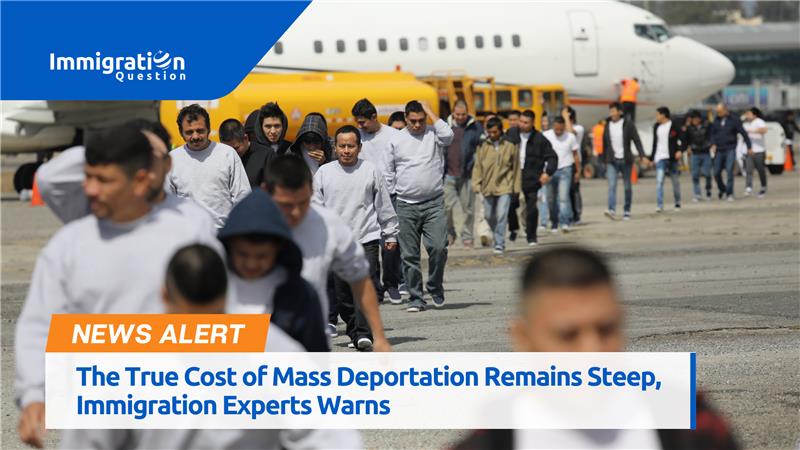The True Cost of Mass Deportation is Too Steep, Immigration Experts Warn
The potential impacts of the mass deportation program promised by Former President Donald Trump have raised substantial concerns among immigration experts, who argue that the costs involved could be devastating for both the U.S. economy and millions of American families.
While proponents of mass deportation claim it would open jobs for American workers, research suggests the reality is far more complex and costly, impacting a wide range of sectors, from agriculture to healthcare and construction.
As U.S. politicians discuss immigration policies, experts are raising alarms about the steep costs of mass deportations, costs that go beyond the logistical expenses of removal and detention and spill into broader economic, social, and human impacts.
“Billions Down the Drain” would not be a Figure of Speech
The American Immigration Council estimates $88 billion to deport just 1 million undocumented immigrants a year and a total cost of $967.9 billion over the course of more than a decade. This would also lead to the removal of millions of construction, hospitality, and agriculture workers could reduce the U.S. gross domestic product by $1.7 trillion.
Tom Homan, who led U.S. Immigration and Customs Enforcement during the first Trump administration, said he could not speak to the $88 billion a year cost and insinuated that we can’t put a price on national security. Matt Elliston, Director of ICE’s Baltimore field office, has noted that the resources needed to carry out mass deportation in Maryland alone is the “Department of Defense level of financing.”
The ICE chief of staff during the first two years of the Biden administration also noted it costs $150 a night with an average wait of 46 days for deportation, for which one deportation flight costs about $250,000.
The American Immigration Council report also estimates the one-time cost of deporting all undocumented immigrants currently residing in the U.S. to be at least $315 billion.
The Unrealistic Labour Demand for Cost of Mass Deportation
Besides the outrageous cost of deportation, there would be an enormous request for labor. In a raid in Maryland, it took a team of a dozen officers seven hours to arrest just six people; this is not considering the time expended to search for them.
In Maryland, the ICE deportation branch has about six thousand officials, but mass deportation would require up to one hundred thousand officers, about Ninety-four thousand more officers, ranging from field-specialized officials to management officers.
Economic Burdens and Labor Market Disruptions
The loss of undocumented workers would shrink the U.S. GDP by 4.2% to 6.8%, significantly contracting the economy’s reduction in tax revenues for the U.S. government. Industries like agriculture, construction, and hospitality, which rely heavily on undocumented workers, would have a significant impact as their removal would leave a massive labor gap, which U.S.-born workers are unlikely to fill. In fact, following a past crackdown on undocumented workers, researchers observed a decline in both job numbers and wages among American-born workers, underscoring how closely intertwined undocumented labor is with overall economic health.
A report by the American Immigration Council shows that In 2022 alone, undocumented immigrant households paid $46.8 billion in federal taxes and $29.3 billion in state and local taxes. Undocumented immigrants also contributed $22.6 billion to Social Security and $5.7 billion to Medicare.
Undocumented workers contribute around $256.8 billion annually to the economy through consumption. Removing this spending power would strain local businesses, further increasing unemployment and potentially leading to business closures. This kind of shock, some analysts say, would ripple through other industries dependent on immigrant labor, leading companies to either struggle with costs or resort to automation, further cutting American jobs.
Social Costs on Families and Communities
Beyond finances, mass deportation poses grave humanitarian and social costs. Families would face traumatic separations, and communities would be torn apart, disproportionately affecting U.S.-born children of undocumented immigrants.
Mass deportation would also profoundly affect millions of American families. According to the Center for Migration Studies, about 9.7 million U.S. citizens live in households with undocumented relatives. Deporting these individuals would not only tear families apart but also leave approximately 5.5 million U.S.-born children without one or both parents.
Looking Ahead: The True Cost of Mass Deportation is Too Steep, Immigration Experts Warn
Experts warn that the costs of mass deportations are not only financially unviable but also morally and socially detrimental. The logistical, economic, and human tolls reinforce the call for more balanced immigration policies that support economic stability and social unity rather than focusing solely on removal. In the words of Matt Elliston, “immigration law is second to the U.S. tax code in complexity.”
To stay updated and informed, keep an eye out for our news section or drop your immigration queries for professional attorneys to reply on Immigration Question.








